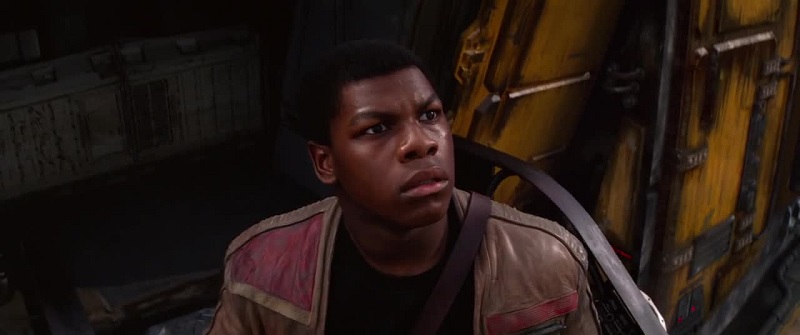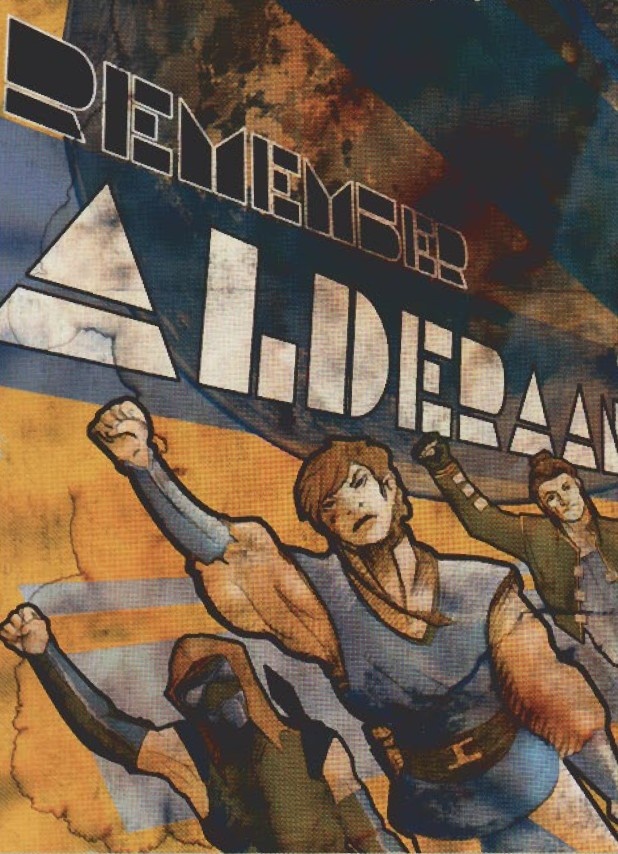
There’s been a sense from some fans that The Force Awakens and its background material indicates that the New Republic has been a failure, that all the heroes fought for has been for naught. Not everyone thinks that – Nick previously wrote to take stock of the New Republic as seen in the context of TFA and the Journey to TFA books and his verdict was a positive one. But since then, Bloodline has been released and given us a great deal of context about the dysfunction that paralyzed the New Republic in the years leading up to the film. Sarah discussed the role extremism and partisanship played in impeding the New Republic’s governance, and Sarah, Rocky, and yours truly discussed how these irreconcilable differences stemmed from fear and mistrust. After all that, one might be forgiven for assuming that the rosy view of the New Republic was definitely wrong and that TFA showed the demise of a government that was at best a failure and at worst, doomed. But is that the right lesson to take from Bloodline? We don’t think it is – Bloodline simply showed democracy as it is, warts and all.
As promised with our first “Gray Matters” piece on Lost Stars and its realistic and human portrayal of those who serve the Galactic Empire, here’s our follow-up on how to realistically portray the good guys. And just like the first piece, the article didn’t really come together until Claudia Gray wrote a novel perfectly demonstrating what we wanted to talk about: how democracy is portrayed in Star Wars and why it’s important that it be treated with nuance. As with the first Gray Matters piece, the goal is to make it clear that there isn’t and shouldn’t be a black-and-white sense of the New Republic – complexity and nuance is more interesting than unmitigated success and failure.
So here’s the thing about democracy – it isn’t about efficiency. A gloriously Arthurian Republic, like the description of the Old Republic in the Journal of the Whills or The Princess, the Scoundrel, and the Farm Boy, is the ideal but such wonders take work. The ideals of the Old Republic have fallen, become corrupted, and resulted in the Empire. The Rebels could attempt to rewind the clock, pick up where the Old Republic left off – or they could try a bold new experiment, and hope that they could usher in a New Republic worthy of the heyday of the old. Experiments are leaky, creaky, and often have problems – especially once they’re no longer fresh out of the box. The New Republic has already fallen victim to its own success, but the NR’s complacency is a sign that it worked. The NR won, the NR established peace, and now the NR has to deal with all the issues that could be overlooked when everyone was flush with victorious unity and cheer. That’s not failure – that’s expected. What matters is how those problems are dealt with, and Bloodline showed us a New Republic that was able and worthy to right the ship of state had it not been capsized by the First Order.
Same Thing, Different Results?
The New Republic of Bloodline is the culmination of the government ushered in during Aftermath, and briefly outlined in the Visual Dictionary and Before the Awakening. It’s similar to the Old Republic in some aspects (a chancellor, a Senate, multispecies tolerance, demilitarization, etc.) and vastly different in others (no executive to speak of, a rotating seat of government, and fierce egalitarianism). The experiment was bold, but even in September 2015 folks suspected that some of the more idealistic aspects would lead to problems down the road because the First Order was on the horizon. And if not that, then demilitarization and idealism would leave another problem deferred. By Bloodline, we see the birds come home to roost, the theory goes. But is that true?
The flaw of the New Republic of the Legends EU was that it tried too hard to imitate the Old Republic. While the character of that imitation in-universe changed as the prequels altered our concept of the Old Republic government, the essential premise was always that the Alliance to Restore the Republic did just that. To keep a very long story short, the New Republic did eventually fall prey to the same corruption of the Old Republic because it failed to address its fundamental weaknesses. The New Republic just tried again, and expected a different result because surely the example of the Empire would mean that democracy wouldn’t want that outcome again. But the New Republic fell – to an assault it was inadequately prepared for. That’s a vast oversimplification and it’s certainly arguable that the New Republic of the EU wasn’t doomed to failure at all, but to a certain extent it was damaged goods with damaged credibility.
The canon New Republic tried something dramatically different. Perhaps a little crazy even. It had the luxury of being bold, as it won the Galactic Civil War more swiftly than anyone could’ve expected. Swept up in this idealism, the notion of a bold new experiment was a winning one. A Republic not governed by the ancient ruling world of Coruscant (aw!); a Republic not consumed with aristocracy, pomp, and circumstance (aw!); and a Republic demilitarized and focused on healing the rifts of the past.
We don’t have the stories of the early days of the New Republic yet, but we know it worked. We know there were decades of peace after the Battle of Jakku, and we know that the galaxy healed. The promise of a brighter day was delivered. By the opening pages of Bloodline, that promise seemed like it had dimmed significantly. New problems had arisen, and the Senate was too paralyzed to do anything about it – it was concerned with form over substance. But here’s the thing: such was the New Republic’s staggering success that it had the luxury to fall into decadence. And it wasn’t a decadence caused by a few years of peace, as in the EU, but decades of peace.
An era of light and hope and magic couldn’t last forever. That’s not depressing, but matter-of-fact. The New Republic had succeeded wildly beyond its dreams, and was able to defer issues to another day – the Empire fell so quickly that the issue of those who benefited from the Empire could be deferred, and it fell so quickly that it could be a seductive myth to those who had never truly known it. Uniting for peace and freedom was the easy part, agreeing what came next is harder – and that’s a natural part of democracy, because people disagree. And that’s where Bloodline shows us the reality of the New Republic.
Governing in Prose
So how is it that a New Republic that has begun with such promise has already fallen into decline? It’s well and good that the New Republic has won so thoroughly that it’s possible to be corrupt, but isn’t it a problem that it’s so compromised already? Not actually – the rosy beginnings of the New Republic obscured issues that are now rearing their head. Peace may have been established and the war ended, but issues of class and corruption and Imperial loyalism were simply deferred by the New Republic’s sudden victory, not wholly erased by them. And that’s where Claudia Gray gives us the most realistic look at the New Republic.
That’s not to say that dysfunction is natural for democracy, or that the New Republic was doomed to corruption. That’s a pro-First Order, pro-dictatorship argument and that’s emphatically not true. But a New Republic that took a bold step to break away from the past couldn’t reasonably expect that period of warm fuzzy feelings to last forever. Combined with some decisions – such as a powerless chancellery – we have a recipe for decline. The important takeaway, however, is that changes both reasonable and questionable have now come home to roost. As we learn in this novel, the question isn’t whether the New Republic is worth saving – but how to save the New Republic.
As Leia despairs of throughout the novel, the Galactic Senate is riven into two political factions: the Centrists and the Populists. Though the specter of a legislature paralyzed by partisan bickering may resemble contemporary politics, Claudia Gray has made it clear both in interviews and throughout the text that the parties are not mere cyphers for contemporary political parties. Commentary on political dysfunction and politics there may be, but the differences between the parties are thoroughly rooted in in-universe concerns. This not only makes the conflict between them more compelling and immersive, but it strengthens the narrative because these are the sort of issues that you might imagine partisan blocs forming over. There would be nothing more damaging to the narrative than the sense that the conflict between the parties were arbitrary or inexplicable.
The Centrists and Populists have very real differences, though. In a post-Palpatine galaxy, the decision whether to centralize authority or leave it diffuse is not a small thing. It’s only been two decades since the fall of the Empire, and another two since the Clone Wars – those wounds are still very raw. Compare It to 1990, where Margaret Thatcher vociferously opposed George H.W. Bush’s notion to have Germany reunified – 45 years after the end of World War II, with a West Germany solidly part of NATO, the memories of German power in the two world wars were still frightening. Beyond issues of authority, the parties have their own internal divisions as well: some Centrists believe state power should be used to regulate aspects of daily life, others believe each world needs an immensely strong military. Some Populists believe in direct democracy, while others want to increase the sovereignty and independence of local systems. These parties have wings, and though they are like-minded for the larger issues they differ on the smaller ones. But all of these concerns are plausible for a post-Endor, post-Jakku government that has to address problems that may have been put off earlier. (And as noted, these political issues don’t easily map onto one American political party or another – because that’s not the point).
Not just Vader’s legacy
The politics of the past create the issues of the future. Just as the trauma of the July Monarchy and the Second French Empire dominated the politics of the Third French Republic, it also spawned the fissures that caused the Third Republic to fall in a relatively short manner to an external invasion. The centralizing trend of the late Old Republic and the Galactic Empire led to both the Clone Wars and the Galactic Civil War, and spawned a more decentralized New Republic. But now there’s a centralizing reaction – both in terms of Imperial nostalgics and the First Order.

The politics of the past also make it difficult for Leia – as far-sighted a leader as the Rebellion and New Republic ever had – to see past the shadows of the Empire. She knows unity and consensus are the only way the New Republic can govern an entire galaxy with disparate views and concerns, but even she has trouble with it. She doesn’t trust any Centrists, and takes a while to warm up to Ransolm Casterfo. In reality, compromise with Casterfo would’ve been the answer to get things done – but she doesn’t trust the Centrists. Moreover, the Centrists don’t trust her – her popularity is a threat to them because she opposes their agenda. That she might possibly usher in stronger government that suits their purposes is beside the point, and the Centrists are beside themselves with glee when she’s kicked off her high perch.
That brings us to the revelation and how quickly things fall apart for Leia. Realistic? You bet. Leia’s a great hero, and an immensely popular politician. That’s why her fall from grace is so sudden – it’s not because people suddenly forgot, it’s that she had so tremendously far to fall and she had a lot of enemies just happy to see it happen. In time, if not for the rising First Order, Leia’s reputation would have assuredly recovered – even if she had retired. But her enemies taking advantage of a deep attack on her credibility, her allies deeply concerned about the partisan consequences of publicly associating with her? Thoroughly plausible. Certainly her true friends and allies do and should stick by her, but her allies of convenience, her associates? Scandal is not a well from which power can be drawn.
Out of time in the end
There is so much more we could discuss about the politics of Bloodline and where the New Republic ended up (Casterfo alone might warrant a whole piece!), but suffice it to say that the New Republic’s bumps in the road are to be expected. Democracy isn’t pretty and democracy isn’t easy – neither is drastic change. Sometimes that results in failure – witness the Arab Spring and the breakdown of democracy in Egypt, so soon after its hopeful start. The results of free choice, the consequences of losing elections, the emphasis on the democratic process and republican system instead of on winning are not easy tonics. Sometimes you have to lose some to win some, but the result is worth it.
Leia despaired of the state the New Republic was in, given all that she had sacrificed for it and all the hope she had for it. But she knew in time it could have been saved, and that it was worth saving. She knew the corruption, the deferred issues of Imperial loyalism, corruption, distrust of public authority, etc. were all solvable problems. But she just ran out of time – the First Order was coming, and it had to take her down to get where it needed to go. She was their greatest threat.
So the New Republic cast aside its greatest champion and best hope, for short term political advantage. That, too, is realistic. And that too might’ve been survivable. But it wasn’t – and the New Republic’s tottering state, with agents of its destabilization eagerly looking on, is the natural consequence of its sudden victory and integration of all those it defeated. Glorious and magnanimous at the time, it planted dark seeds for the future.
But the novel ends up a hopeful note: Leia absorbed the lessons of the past. She’s ready to fight on – part Churchill, part de Gaulle. So it’s not really a dark end for the New Republic at all – illuminated on both ends, its establishment and its hopeful successor in the Resistance, the New Republic is cast in gray tones. It was hard work establishing it, harder still to keep it together, and hardest yet to bring something like it back after the First Order is through with it. But it’s great to see and I’m glad Claudia Gray showcased the New Republic’s struggles in the Leia political novel we’ve always wanted.

Great piece Jay. I’m inclined to agree with you.
Neat piece Jay, a really smart read.